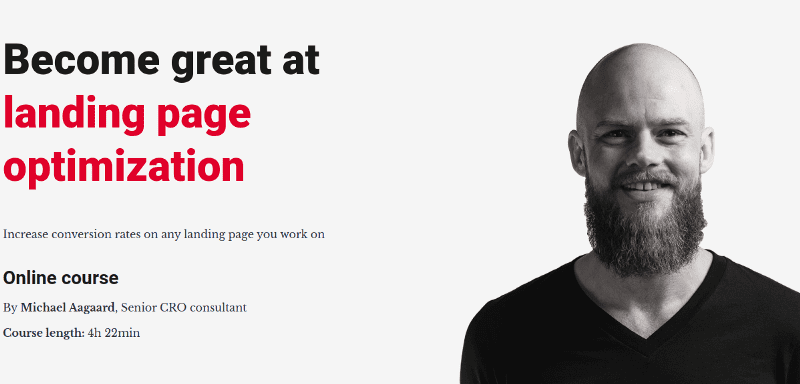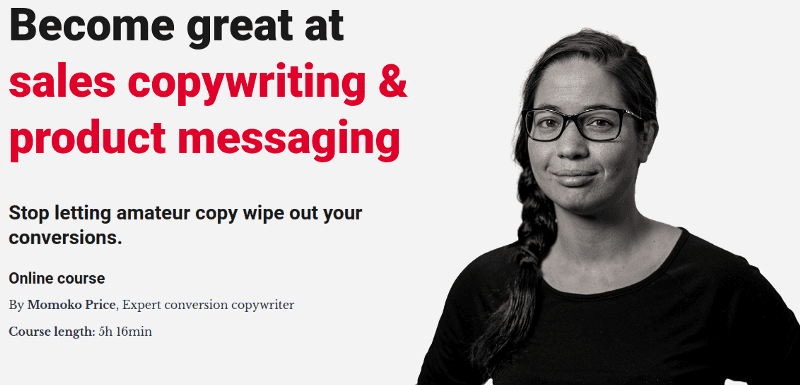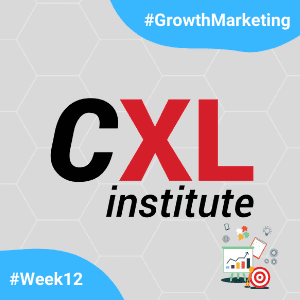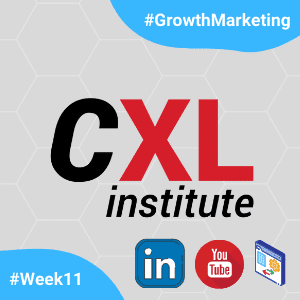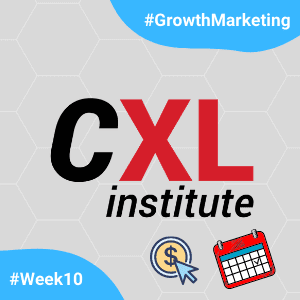Completing another week of Growth Marketing Minidegree, I finally arrived at the section on Conversion, one of the most anticipated in the course!
The section is divided into two courses focused on increasing conversion rates: Landing Page Optimization, taught by Michael Aagaard and lasting just over 4 hours, and Product Messaging, by Momoko Price, over 5 hours.
Each week, as part of the CXL Institute’s Scholarship Program, I write a little about the courses studied. The program lasts 12 weeks, and so far I have already written the following texts:
- Week 01: organization of the course and the relevance of the theme.
- Week 02: importance of carrying out growth experiments.
- Week 03: A / B tests and fundamentals of statistics for more assertive results.
- Week 04: Google Analytics for beginners. Main features, reports and analysis.
- Week 05: Intermediate Google Analytics. More advanced features, personalized views and methods to find solutions.
- Week 06: Google Tag Manager for Beginners. Basic features of an essential tool for collecting user behavior data.
Below, I briefly write about some of my perceptions about the two courses.
Landing page optimization
The Landing Page Optimization (LPO) course is ideal for those seeking a more structured view of the optimization process using the best resources of research, data and user psychology. Using a scientific approach, focused on objective information, Michael Aagaard shows how to analyze landing pages and build efficient optimization strategies, using techniques and research methods. In addition, the instructor explores topics related to user psychology and copywriting.
The course starts with a presentation on how is the experience is on a landing page, in which the instructor explains what is the role of a landing page and what are the features that influence the user experience. Understanding what are the relevant characteristics and what issues should be avoided, the path of optimization begins to take shape. In this first part of the course, we learn where to start.
With the starting point defined, we immerse ourselves in the understanding of the user psychology. Michael shows how the decision process works, how Fast and Slow thinking determines the user’s behavior and what are the cognitive biases of human psychology.
To better understand the psychological element of the decision-making process, we also study how brain chemistry works in a lesson on neuroscience, in which we explor two of the most important chemicals relevant to the landing page experience: Cortisol and Dopamine. In this part, we see strategies for creating a great user experience and avoiding some common mistakes that affect user perception and can compromise sales.
Having understood how the user’s decision process works, we start to build the landing page. For this goal, Michael shows how to organize a hierarchy of logical and well-structured information for the page. When the structure is defined, it is possible to understand how much content is needed and in what order it should be presented, in addition to facilitating analyzes about the purchase motivations and barriers that potential customers / leads may face.
Until then, we understand user behavior and how to create structures to present information in the best possible way. Next, the instructor shows how to evaluate the work done, both quantitatively, using information from Google Analytics, answering questions “where”, “what” and “who”, and qualitatively, analyzing feedbacks from users and answering “why” questions.
Finally, the instructor concludes the course with valuable information on two key elements in the construction of landing pages: copywriting and design. The LPO process is strongly based on these two elements, since they make the content and the visualization that the user will have of a product or idea, on a sales or lead acquisition page. Michael shows the main aspects of copywriting and its elements, in addition to offering formulas and templates so that we can already start creating our content. In the design section, we see the 6 most important elements and how to organize them in a visual hierarchy so that the optimization process is effective.
Product messaging
The Product Messaging course is a great solution to problems related to copywriting, giving answers to anyone who feels that the content on their site is disorganized and the message to the user can be confusing. In this course, Momoko Price presents solutions for pages whose traffic simply won’t increase and methods for organizing the website’s content in a clear, structured and well-documented way.
We start the course with a “Teardown” from our sales page. The instructor guides us through the process of deestructuring our page and understanding how persuasive it is. Next, we learn how to identify problems and prioritize solutions, in order to improve the efficiency of our page.
Next, Momoko presents the concept of “Message-Mining”, showing how it is possible to analyze messages and obtain valuable sources of content for our audience, whether on related pages or even in messages from customers (surveys, interviews, tests of user and other feedbacks), which serve as a source to create a convincing narrative and, from there, generate content consistent with what is important to the user.
With the “Message-Mining” process properly carried out, we proceed to the construction of an Effective Unique Value Proposition. In this section, Momoko even presents us with a framework that can be reapplied to develop value propositions for almost any product, even if it is a niche.
Having the message information defined, the instructor shows how the hierarchy of the content is essential. Even a good message, with relevant content, may have less persuasive power depending on the context in which it is presented. Understanding what needs to be communicated first is essential to building a compelling story and showing a value proposition that speaks to the user’s need.
Finally, Momoko presents three steps for launching the developed content: creating the first draft, editing and formatting. Some technical aspects are treated in this part and, at the end, Momoko shows how to create layouts and formats that are focused on conversion, presenting content visualization techniques, organizing the page design and creating functional prototypes to present to the team or clients.
Next week…
In the next few days I will start studying the courses within the Channel-specific growth skills section, which teaches a series of strategies on how to deal with each of the available channels. As seen in the section on Conversion, understanding the end user and showing the right message in the right place at the right time is key to making yourself understood. The next section should help with this challenge.
We’ll find out next week. See you then!

